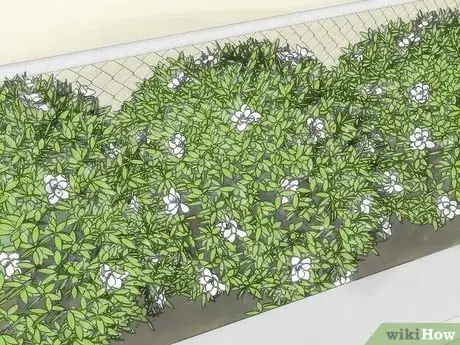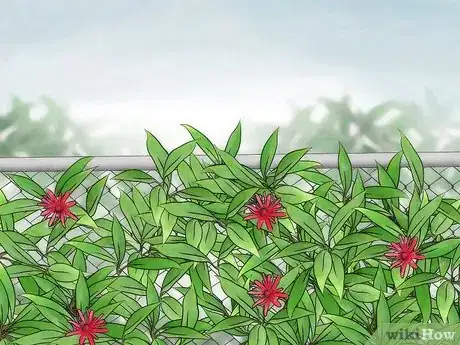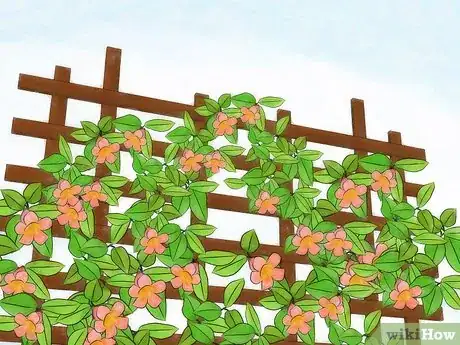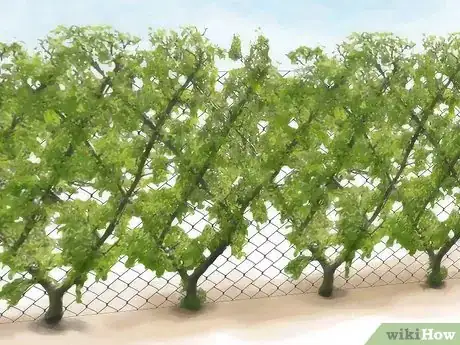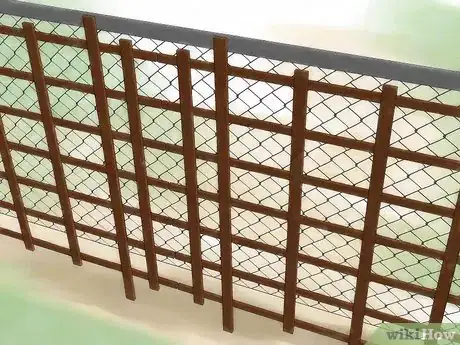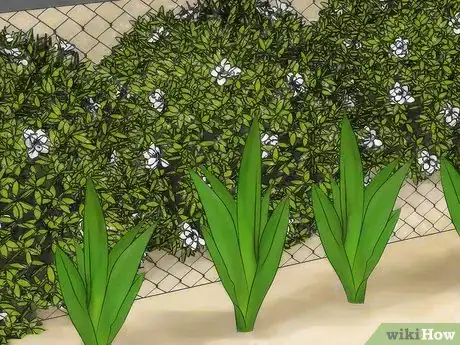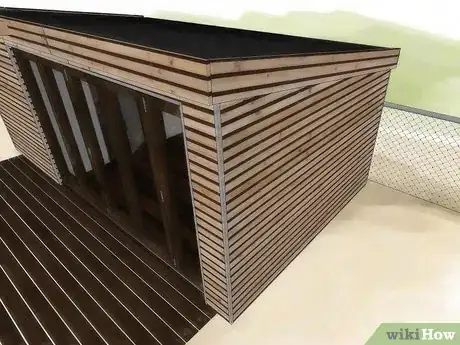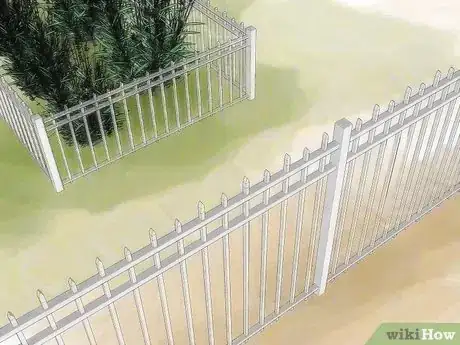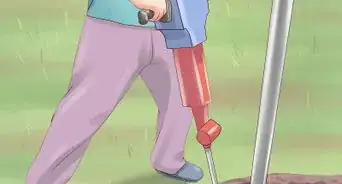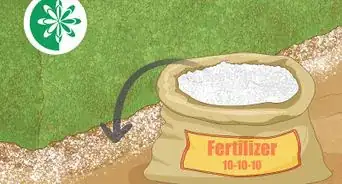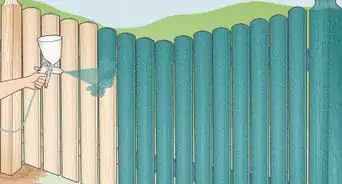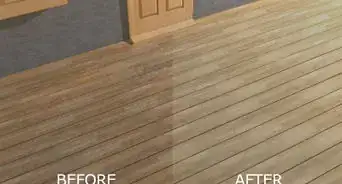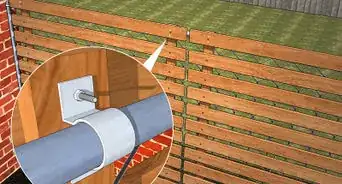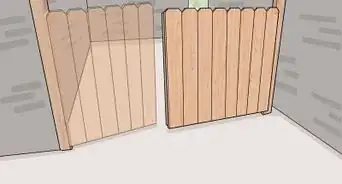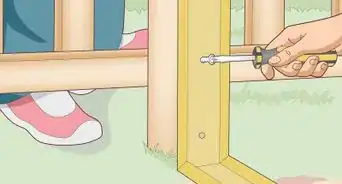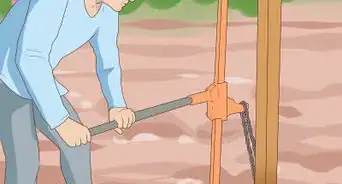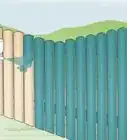This article was co-authored by Grant Wallace. Grant Wallace is a Landscaper and Owner of Grantlanta Lawn in Atlanta, Georgia. With over seven years of experience, he specializes in lawn maintenance and landscape installation. In 2012, he earned his BA from the University of West Georgia. Grant has been profiled in Shoutout Atlanta, Canvas Rebel, and Voyage ATL.
This article has been viewed 101,547 times.
So your neighbor just installed a fence between his home and yours. It runs straight across the yard from the back of your homes, to the sidewalk. It's one straight line, and as plain as a fence at the zoo. If you can't stand looking at it, cover your side with something more pleasant looking.
Steps
-
1Plant a vine. A few Wisteria will grow quickly to cover the fence.[1]
-
2Choose a hedge for shady sites. Hedges grow more slowly than vines, but they will cover better. Here are some suggestions for shade-loving hedges:[2]
- Eleutherococcus sieboldianus 'Variegatus' (Variegated Five-leaf Aralia) is really pretty with variegated foliage, grows easily in most soils, and reaches 6–8 feet (1.8–2.4 m).
- /Symphoricarpos spp. (snowberry/coralberry)will grow fast almost anywhere, suckers freely, grows to about 6 feet (1.8 m) tall. It makes persistent berries for winter interest.
- Cherry-laurel has the advantage of being evergreen.
Advertisement -
3Plant a hedge for southern climates.
- Florida Anise makes a nice, dense, sweet scented hedge.[3]
-
4Put up your own support. If you really want to get away with a vine for the speed, but can't plant over your neighbor's fence, put up a simple fence or trellis of your own (maybe just wire between poles) and grow something over it fast. Crossvine, Dutchman's pipe, and some jasmines will all grow in deep shade. Even green beans or peas could be a quick cover. You could even make that a temporary measure while you find something else to plant in there.[4]
-
5Plant a shade-loving vine:
- Sambucus nigra 'variegata' - this gorgeous thing is a beacon even in full shade, and is pretty drought tolerant to boot. It can be trained upright along steps or a wall to well over 12 feet (3.7 m). It is deciduous.
-
6Plant a sun-loving cover.
- Physocarpus opulus (either the green-leaved variety or "Diabolo", the purple leaved one). Also deciduous.
- Ceanothus thyrsiflorus: evergreen, and impenetrable once in full growth.
-
7Plant for intermediate or mixed conditions:
- Leycesteria formosa: this bamboo-like shrub has shoots that can go 6 feet (1.8 m) in a season once established.
- Viburnums. There is one for every occasion. Viburnum x juddii is fragrant, and growing in part shade for me. Viburnum rhitidophyllum (leatherleaf) is dark and would look fabulous against that fence.
- Hamamelis. "Diane" can reach to 12 feet (3.7 m). The fragrant yellow ones are even nicer and more vigorous.
-
8Show some of the fence, but cover it with something. Try an espalier in front of the fence.
-
9Do something besides a hedge. Can you build a gazebo or trellis in front of the fence?[5]
-
10Use plantings on the other side of the fence as an element in your own garden. If you can see a plant over or through the fence, plant two lower plants on your own side and your plants will look like a grouping, even though one of them is not yours. This can help to soften the appearance of a barrier.
-
11Use the idea of garden rooms. If you have even a bit of space, place something so that there is more garden beyond it. It will keep the feet and the eyes moving, soften the edges, and still conceal the fence from view out the window or from the patio that you want to use.
-
12Incorporate the fence in your own style. Depending on the appearance of the fence, add coordinating elements that tie it into your own garden. For example, if it is a white, metal fence, you could use a shorter white metal fence or border somewhere in your own garden.
Community Q&A
-
QuestionIs a willow shrub good for hiding a fence?
 Community AnswerNo, it's deciduous. You need an evergreen shrub that can be trimmed into a hedge.
Community AnswerNo, it's deciduous. You need an evergreen shrub that can be trimmed into a hedge.
Warnings
- Are they going to let you grow things up THEIR fence?⧼thumbs_response⧽
- Beware of planting invasive species. Things like ivy and bamboo can cover a fence in fairly short order, but they can also take over part of your garden just as fast.⧼thumbs_response⧽
Expert Interview

Thanks for reading our article! If you'd like to learn more about planting a hedge, check out our in-depth interview with Grant Wallace.
References
- ↑ https://www.gardendesign.com/wisteria/
- ↑ https://apnews.com/0d8db19e6f2941618b62a9bd8f7a0281
- ↑ https://www.uaex.edu/yard-garden/resource-library/plant-week/anise-florida-2-10-12.aspx
- ↑ https://www.bhg.com/gardening/landscaping-projects/landscape-basics/easy-yard-privacy-tips/?slide=slide_87b59a47-9c4b-4301-8310-33c303ce0723#slide_87b59a47-9c4b-4301-8310-33c303ce0723
- ↑ https://www.bhg.com/gardening/landscaping-projects/landscape-basics/easy-yard-privacy-tips/?slide=slide_87b59a47-9c4b-4301-8310-33c303ce0723#slide_87b59a47-9c4b-4301-8310-33c303ce0723

